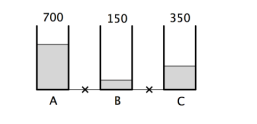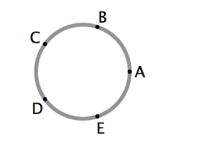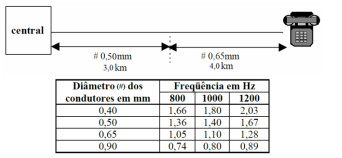No MS Word 2010, sobre o uso de caracteres coringas para localizar palavras em um documento texto, é correto afirmar que:
Em um prédio há três caixas d'água chamadas de A, B e C e, em
certo momento, as quantidades de água, em litros, que cada uma
contém aparecem na figura a seguir.

Abrindo as torneiras marcadas com x no desenho, as caixas foram
interligadas e os níveis da água se igualaram.
Considere as seguintes possibilidades:
1 A caixa A perdeu 300 litros.
2 A caixa B ganhou 350 litros.
3 A caixa C ganhou 50 litros.
É verdadeiro o que se afirma em:
A figura abaixo mostra uma pista circular de ciclismo dividida em
5 partes iguais pelos pontos A, B, C, D e E.

Os ciclistas Marcio e Paulo partem simultaneamente do ponto A,
percorrendo a pista em sentidos opostos. Marcio anda no sentido
horário com velocidade de 10km/h, Paulo no sentido anti-horário
com velocidade de 15km/h, e eles se cruzam várias vezes.
Marcio e Paulo se cruzam pela terceira vez no ponto:
Analise as seguintes afirmativas a respeito dos padrões de canalização utilizados em Sistemas de Transmissão digitais multiplexados no tempo. I O padrão PDH possui cada canal multiplexado operando de forma plesiócrona. II O padrão SDH de transmissão de sinais foi concebido para uma arquitetura de multiplexação síncrona. III O sinal PDH transporta os diferentes tipos de sinais SDH. Está correto somente o que se afirma em:
A tecnologia GPON (Gigabit Passive Optical Network) derivada das redes ópticas passivas PON (Passive Optical Networks) é uma das opções para atender as novas demandas por aumento de banda. A respeito do GPON, é correto afirmar que:
Para os meios de transmissão horizontais, conforme figura
abaixo, as distâncias dos trechos compreendidos entre o
Gabinete de Telecomunicações e as saídas de informações são
estabelecidas pela Electric Industries Association – EIA

Utilizando cabos de fibra óptica, UTP e STP, as distâncias máximas
permitidas, em metros, são respectivamente iguais a:
Analise as afirmativas abaixo a respeito de uma rede de computadores, considere V para a(s ) afirmativa(s ) verdadeira ( s) e F para a(s ) falsa( s). ( ) Acurácia mede a quantidade de trafego útil corretamente transmitido, relativo ao tráfego. ( ) Jitter é uma medida da capacidade de enlace. ( ) O uso do buffer é uma das formas de minimizar os efeitos da variação do atraso da entrega de dados. A sequência correta é:
A respeito do Simple Network Management Protocol – SNMP, analise os itens a seguir: I.Utilizado para trocar informações de gerenciamento de redes, é utilizado o protocolo padrão. II Pouco utilizado em redes de dados baseada no TCP/IP. III Baseia-se no modelo cliente e servidor. Está correto somente o que se afirma em:
Um determinado enlace entre central e assinante é apresentado
na figura abaixo, juntamente com a tabela com valores de
atenuação em dB/km dos pares trançados utilizados nesse
enlace:

A atenuação desse enlace para frequência de 1000 Hz é:
A tecnologia que permite o uso para a telefonia e transmissão de dados na família DSL é:

Mining tourism in Ouro Preto
Ouro Preto is surrounded by a rich and varied natural
environment with waterfalls, hiking trails and native vegetation
partially protected as state parks. Parts of these resources are
used for tourism. Paradoxically, this ecosystem contrasts with the
human occupation of the region that produced, after centuries, a
rich history and a cultural connection to mining, its oldest
economic activity which triggered occupation. The region has an
unlimited potential for tourism, especially in specific segments
such as mining heritage tourism, in association or not with the
existing ecotourism market. In fact, in Ouro Preto, tourism,
history, geology and mining are often hard to distinguish; such is
the inter-relationship between these segments.
For centuries, a major problem of mining has been the reuse of
the affected areas. Modern mining projects proposed solutions to
this problem right from the initial stages of operation, which did
not happen until recently. As a result, most quarries and other
old mining areas that do not have an appropriate destination
represent serious environmental problems. Mining tourism
utilizing exhausted mines is a source of employment and income.
Tourism activities may even contribute to the recovery of
degraded areas in various ways, such as reforestation for leisure
purposes, or their transformation into history museums where
aspects of local mining are interpreted.
Minas Gerais, and particularly Ouro Preto, provides the strong
and rich cultural and historical content needed for the
transformation of mining remnants into attractive tourism
products, especially when combined with the existing cultural
tourism of the region. Although mining tourism is explored in
various parts of the world in extremely different social, economic,
cultural and natural contexts, in Brazil it is still not a strategy
readily adopted as an alternative for areas affected by mining
activities.
(Lohmann, G. M.; Flecha, A. C.; Knupp, M. E. C. G.; Liccardo, A.
(2011). Mining tourism in Ouro Preto, Brazil: opportunities and
challenges. In: M. V. Conlin; L. Jolliffe (eds). Mining heritage and
tourism: a global synthesis. New York: Routledge, pp. 194-202.)
Text 1 refers to “hiking trails” (l. 2), which are primarily intended for:
TEXT 2
Innovation is the new key to survival
[…]
At its most basic, innovation presents an optimal strategy for
controlling costs. Companies that have invested in such technologies
as remote mining, autonomous equipment and driverless trucks and
trains have reduced expenses by orders of magnitude, while
simultaneously driving up productivity.
Yet, gazing towards the horizon, it is rapidly becoming clear that
innovation can do much more than reduce capital intensity.
Approached strategically, it also has the power to reduce people and
energy intensity, while increasing mining intensity.
Capturing the learnings
The key is to think of innovation as much more than research and
development (R&D) around particular processes or technologies.
Companies can, in fact, innovate in multiple ways, such as leveraging
supplier knowledge around specific operational challenges,
redefining their participation in the energy value chain or finding new
ways to engage and partner with major stakeholders and
constituencies.
To reap these rewards, however, mining companies must overcome
their traditionally conservative tendencies. In many cases, miners
struggle to adopt technologies proven to work at other mining
companies, let alone those from other industries. As a result,
innovation becomes less of a technology problem and more of an
adoption problem.
By breaking this mindset, mining companies can free themselves to
adapt practical applications that already exist in other industries and
apply them to fit their current needs. For instance, the tunnel boring
machines used by civil engineers to excavate the Chunnel can vastly
reduce miners' reliance on explosives. Until recently, those machines
were too large to apply in a mining setting. Some innovators,
however, are now incorporating the underlying technology to build
smaller machines—effectively adapting mature solutions from other
industries to realize more rapid results.
Re-imagining the future
At the same time, innovation mandates companies to think in
entirely new ways. Traditionally, for instance, miners have focused on
extracting higher grades and achieving faster throughput by
optimizing the pit, schedule, product mix and logistics. A truly
innovative mindset, however, will see them adopt an entirely new
design paradigm that leverages new information, mining and energy
technologies to maximize value. […]
Approached in this way, innovation can drive more than cost
reduction. It can help mining companies mitigate and manage risks,
strengthen business models and foster more effective community
and government relations. It can help mining services companies
enhance their value to the industry by developing new products and
services. Longer-term, it can even position organizations to move the
needle on such endemic issues as corporate social responsibility,
environmental performance and sustainability.
(http://www2.deloitte.com/content/dam/Deloitte/ru/Document
s/energy-resources/ru_er_tracking_the_trends_2015_eng.pdf)
When companies invest in “remote mining, autonomous equipment and driverless trucks and trains” (l. 3-4), it is clear that their goal is to:
TEXT 3
Sustainable mining – oxymoron or a way of the future?
Mining is an activity that has persisted since the start of humans
using tools. However, one might argue that digging a big hole in
the ground and selling the finite resources that come out of that
hole is not sustainable, especially when the digging involves the
use of other finite resources (i.e. fuels) and produces a lot of
greenhouse gases.
The counter argument could go along the lines that minerals are
not being lost or destroyed through mining and mineral
processing – the elements are being shifted around, and
converted into new forms. Metals can even be extracted from
waste, seawater or even sewage, and recycled. But a more simple
argument is possible: a mine can be sustainable if it is
economically, socially and environmentally beneficial in the short
and long term. To be sustainable, the positive benefits of mining
should outweigh any negative impacts. […]
Social positives are often associated with mines in regional areas,
such as providing better amenities in a nearby town, or providing
employment (an economic and social positive). Social negatives
can also occur, such as dust, noise, traffic and visual amenity.
These are commonly debated and, whilst sometimes
controversial, can be managed with sufficient corporate
commitment, stakeholder engagement, and enough time to work
through the issues. Time is the key parameter - it may take
several years for a respectful process of community input, but as
long as it is possible for social negatives to be outweighed by
social positives, then the project will be socially sustainable.
It is most likely that a mine development will have some
environmental negatives, such as direct impacts on flora and
fauna through clearing of vegetation and habitat within the mine
footprint. Some mines will have impacts which extend beyond
the mine site, such as disruption to groundwater, production of
silt and disposal of waste. Certainly these impacts will need to be
managed throughout the mine life, along with robust
rehabilitation and closure planning. […]
The real turning point will come when mining companies go
beyond environmental compliance to create 'heritage projects'
that can enhance the environmental or social benefits in a
substantial way – by more than the environmental offsets
needed just to make up for the negatives created by the mine. In
order to foster these innovative mining heritage projects we need
to promote 'sustainability assessments' - not just 'environmental
assessments'. This will lead to a more mature appreciation of the
whole system whereby the economic and social factors, as well as
environmental factors, are considered in a holistic manner.
(adapted from https://www.engineersaustralia.org.au/westernaustralia-division/sustainable-mining-oxymoron-or-way-future.
Retrieved on August 10, 2015)
When Text 3 informs that elements can be “shifted around” (l.9), it means they can be:
Determinado agente público municipal, em fiscalização de rotina, pratica ato administrativo discricionário, dentro de sua esfera de competência, mas afastando-se do interesse público, eis que a real motivação do ato foi retaliar antigo desafeto. No caso em tela, de acordo com o que ensina a doutrina de Direito Administrativo, o agente público agiu com:
De acordo com a doutrina de Direito Administrativo, os bens de uso especial são aqueles que:

